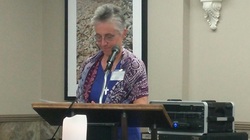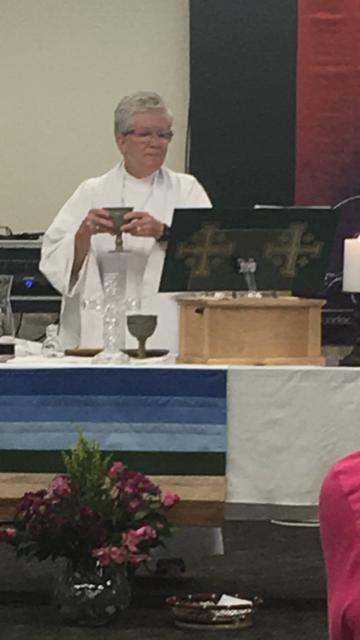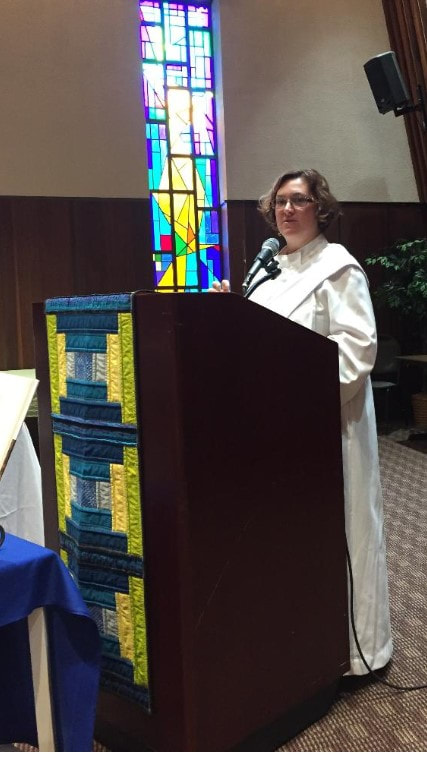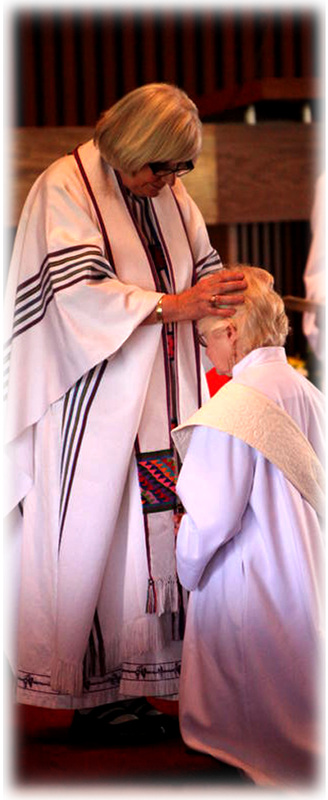
Sr. Barbara Battista, SP, speaking on the Feast of St Mary of Magdala
at St. Mary of Magdala Catholic Community, Indianapolis, IN.
Includes excerpts by Schenk & Miska from Catholic Women Speak and a reading by Gina Messina-Dysert A Need for Multiple Confessions. John 20: 1-18
Claiming Our Space, Our Place in / as the Body of Christ
Mary of Magdala in her deep sadness peers into the empty tomb…angels greet her… she sees someone, only partially, … then, Mary!... and, Rabboni!... and Jesus, the Risen One, commissions her: ”go, to the sisters and brothers and tell them, I am ascending to my Abba and to your Abba, to my God and your God.”… Mary, in her wholeness goes and spreads the word!
We just heard the story. And, if you’re like me you have some questions: Why didn’t the angels appear to Peter and the beloved disciple? Why did those two look inside and seeing an empty tomb just leave? Why did Mary get to see and converse with angels? Did her deep love, her communion with Jesus compel her to stay? Did Mary and the other disciples have different motivations for going to the tomb that morning? I would like to propose that Mary’s seeking Jesus, her willingness to look inside that tomb, to recognize and talk to the angels had a meaning for her unlike anything she had ever done before. Could it be that in her relationship with Jesus she found wholeness, found herself centered, at peace, and ever more able to love without limits? So, in searching for Jesus Mary was searching for, and finding her authentic self. I suggest Mary’s encounter at the tomb shows us how to be whole, to be fully human, fully alive, fully who God created us to be. She shows us too, how to go forth and spread the word! More on that later.
Back to the story. Notice please. She went to, actually into the tomb in her searching. A tomb, more likely tombs, are in our story too. As followers of Jesus, the Risen One, we know that the tomb, our tomb even, is not the end of the story. We also know that tombs come into our lives wrapped in a variety of events: stressful relationships; gravely ill children / spouses / friends; discrimination or exclusion because of who we are or who we love; deep emotional crises; spiritual challenges; and so forth. Seemingly least often is the tomb that receives the sacred remains of our earthly form. And yet, our faithful movement into any of these losses offers us the possibility of new life, of transformation, of claiming wholeness. In our fidelity to the journey, our willingness to look “into the tomb” with our yearning for healing and wholeness, we too, like Mary, can be made whole. We too, can hear our name and be called forth into new life.
So, what might it look like for us to go searching today? Where and how are we being called to search for that fullness of life? Might claiming A Church for our Daughters be another way of saying we are searching for full communion with Jesus, with the People of God that is the Church, that is the Body of Christ? Can we claim that in our searching, in our longing for full communion that we, too, are being made whole?
Angela Nevitt-Meyer proclaimed Gina Messina-Dysert’s Confessions. Such apparently contradictory statements made no less true by their juxtaposition. Just as when Mary heard Jesus call her by name she recognized him, so might we hear our name being called into full communion when we are able to seek out and name those basic realities that sound so contradictory and yet function as the bedrock of who we are as active, faithful, justice-seeking Catholic Christians today. No doubt, there surely is tension in this naming.
Did hearing Messina-Dysert’s multiple confessions help you get in touch with your own confessions? I propose that this way of naming, of taking stock of who we are and where we are in the midst of so many contradictions within our church may in fact free us to be ever more credible witnesses, as Mary was to Jesus’ resurrection, to the full humanity and dignity of women in church and in our society.
Here’s one of my confessions:
I confess that I am happy in my vocation as a Sister of Providence
I confess that my Catholic church, the church I love practices misogyny.
My public confession gave me more clarity, afforded me less anger and frustration, and the grace to be more loving in the midst of such contradictory experiences. I now talk about the oppression of women in our church with my own Sisters, and others, in a true dialogue being respectful and open to another’s experience. This is surely grace!
Consider what your multiple confessions might be. Choose to name them for yourself and perhaps share them with trusted others. I believe that act of naming can become a catalyst of growth for us and our communities. By befriending the paradox, the “both/and” within us, we can live with integrity in that creative tension, allowing something new to germinate and in time be called forth in us.
I believe A Church for Our Daughters is one of the fruits of that tension: A declaration of what our church can be, must become; a description of the beloved community that is whole and wholesome, full and inclusive, proactive and vigilant, recognizing the sacred in all creation. The declaration describes a community within our reach. Among its fifteen points: “(a community that) celebrates and promotes a spirituality that recognizes an inclusive God, beyond gender, and incorporates language that is inclusive and representative of God’s feminine, masculine, and non-gendered attributes in liturgy, doctrine, and pastoral practice.”
A Church for our Daughters is an invitation to revitalize our Church, to welcome Sophia, Wisdom and her power for reforming and transforming our Church into a Church where all are welcome, where all know themselves to be the beloved of God. I encourage you to check out the Facebook and/or webpage for A Church for our Daughters. There you will find the declaration to sign and share. Post it to your social media feeds; discuss it in your book clubs and other faith community gatherings. And, like Mary, spread the word, most especially in your ‘other’ parish.
In welcoming the gifts and leadership of women, all persons will be welcomed into contributing as one among equals. Isn’t that a description of the beloved community? A Church for our Daughters has the potential to help us become a Church for our sons, for those pushed aside, for the least among us, truly for all. For, when we recognize the truth that all are one in the Body of Christ, and put systems in place that support that reality we will no longer tolerate attitudes and systems that breed subordination nor will we support actions that dominate and exclude parts of the Body of Christ.
And so we pray with the closing statement of the declaration: “We pray together as a family of the faithful with the vision of a Church community that at its core upholds the full equality of all of its members. So that our daughters and yours may know radical inclusion and justice, equality without qualification, and an institution that transforms oppression into love without bounds, let us build a Church for our daughters.”
Let us, like Mary of Magdala go to the sisters and brothers today and spread the word!
Barbara Battista, SP
St Mary of Magdala Inclusive Catholic Community
Indianapolis, IN
July 17, 2016



 RSS Feed
RSS Feed

